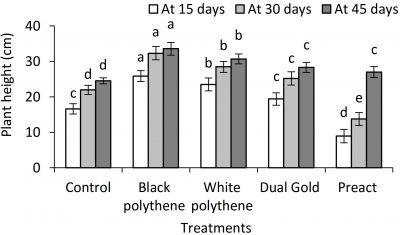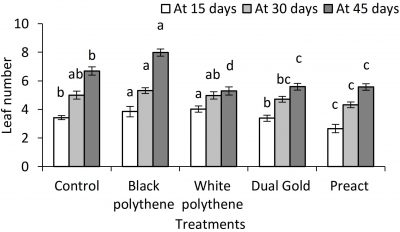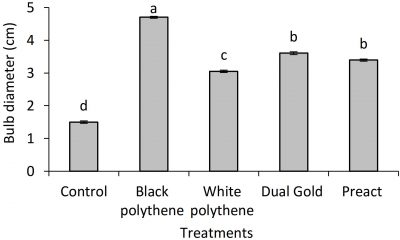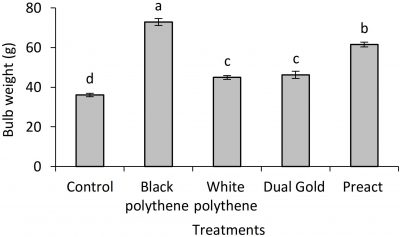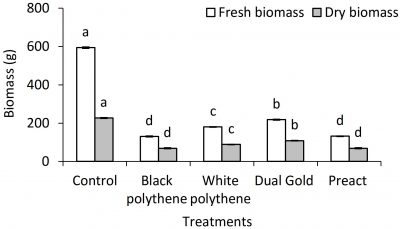ABSTRACT
Onion (Allium cepa L.) is one of the most important vegetables in family Alliaceae, which is cultivated worldwide. In onion, weeds are among one of the major concerns which cause its yield reduction. The present study was designed to assess the effectiveness of different methods for weed control in onion. In this study, five treatments were selected including control, black polythene mulch sheet, white polythene mulch sheet, Dual Gold spray @ 9.0 mL L-1 and Preact spray @ 7.5 mL L-1 to control weeds. The weedicides were applied as pre-emergence sprays before transplanting the seedlings. The experiment was laid out in Randomized Complete Block Design with three replications. From the results, it was concluded that there were significant differences among the studied weed control treatments. Among the five treatments, greater plant height (33.0 cm), number of leaves per plant (8), bulb diameter (4.7 cm) and bulb weight (73 g) were observed in the ridges covered with black mulch sheet. However, the minimum weed biomass (fresh and dry) was recorded in black mulch sheet and Preact pre-emergence weedicide spray (140 and 80 g in both). Thus, black polythene sheet as mulching material was found better option for weed management in onion fields.
INTRODUCTION
Onion (Allium cepa L.) is the member of Alliaceae family, used as vegetable and condiment (Ahmad et al., 1994) . The demand for organic food has increased the need for sustainable organic farming. Onion is grown worldwide for bulb production; however, research on weed management in the crop is limited (Horesh et al., 2019). Onion has dietary, culinary and medicinal significance in everyday life of Pakistani people. It has high water and fertilizer requirements which enhance the threat of weeds. In onion fields, yield loss recorded due to weed infestation is about 40-80% (Channappagoudar and Biradar, 2007; Angiras et al., 2008). Onion plant has slow growing habit, making difficult for it to compete with weeds. Further, due inherent characteristics like shallow root system and narrow leaves with smaller area, onion has very poor ability to compete with weeds (Appleby, 1996) that causes reduction in yield of onion bulbs (Ujjainiya and Choudhary, 2019). At early stages, weeds compete with tender onion plants and harbor disease causing organisms and insects which results in higher crop losses. Thus, farmers should adopt integrated weed management practices other than weed suppression to obtain optimum yield (Ghafoor et al., 2000).
In onion weeds cause reduction in yield and quality (Stephens, 1982) and ultimate loss of profitability. Therefore, weeds must be managed effectively and selectively well in time. There are several techniques to control weeds in onion crop including mechanical, manual, chemical and cultural practices; about 89.9% weeds can be controlled through manual hoeing but it is laborious and high cost method. Numerous alternate techniques proved that herbicides application and cultural practices have been effectively used to control weeds in onion field (Jilani et al., 2003; Ghafoor, 2004; Dhananivetha et al., 2017). Pre-emergence herbicides such as linuron (Femuron®) and pendimethalin (Stomp®) have been reported to reduce the density of weeds in early season and allow the onion crop to develop normally so that weeds that emerge later do not affect the crop (Wang et al., 2018).
Polythene mulch increases soil temperature and soil moisture holding capacity in early spring season. These synthetic mulches reduce weed problems, control insect-pests and also stimulate higher crop yields by more efficient utilization of soil moisture, nutrients and temperature (Kashi et al., 2004). Application of black polythene mulch did not require any other weed control measure and its use resulted in high yield of capsicum and cabbage (Russo et al., 1997). The use of polythene sheets of different color as mulching material for weed management in onion crop is a non-chemical approach. Transparent polythene film increases soil temperature, mean soil water content, onion bulb yield and reduces weed population (Suh et al., 1991). Numerous research trials have indicated that many herbicides can be used effectively and selectively to control weeds in onion (Ghaffoor , 1994). Thus, an effective weed management program is essential for good onion production. Based on above discussion, this study was therefore, conducted to compare the effectiveness of different weed control practices (chemical and polythene sheets of various colors) in onion crop grown in arid region of Bahawalpur.
MATERIALS AND METHODS
A field experiment was carried out in the Research Area of Department of Horticultural Sciences, Faculty of Agriculture and Environmental Sciences, The Islamia University of Bahawalpur (Pakistan) during 2017-18. Seeds of onion cultivar Desi Red were sown on 16th November 2017 in nursery on raised beds to grow seedlings. About 45 days old uniform sized seedlings were taken from the nursery and transplanted in the field after land preparation, on ridges prepared 45 cm apart on 1st January 2018. The experiment was laid out in Randomized Complete Block Design (RCBD) with five treatments (T1 = Control, T2 = Black mulch sheet, T3 = White mulch sheet, T4 = Dual Gold pre-emergence spray and T5 = Preact pre-emergence spray) and three replications. Plants in control treatment (T1) received no mulching sheet and no pre-emergence weedicide spray. In the treatments T2 and T3, black polythene sheet and white polythene sheet were used to cover the ridges; while in T4 and T5, pre-emergence weedicides Dual Gold (S-Metolachlor 40%) @ 9 mL L-1 and Preact (S-Metolachlor 83%+ Pendimethalin 13%) @ 7.5 mL L-1, respectively were sprayed. In case of treatments T2 and T3, the ridges were covered with black and white polythene sheet mulches, respectively, and then the field was irrigated. Immediately after irrigation, Dual Gold and Preact weedicides were sprayed in the experimental units of T4 and T5, respectively. The seedlings were shifted to the ridges at a plant to plant distance of 15 cm in the standing water in all the experimental units including control. There were 25 seedlings in each experimental unit.
Plant height and total number of leaves/plant were recorded on 15 days interval after 15, 30 and 45 days of transplanting of seedlings. Bulb diameter (cm) and bulb weight (g) were taken at the time of harvesting (30th April 2018). For weed control efficacy, one-meter quadrates were selected, and weeds were harvested at the time of crop harvest. Total fresh biomass of weeds was calculated by weighing fresh weed weight and these harvested weeds were sun dried for a week and dry biomass was also calculated.
Statistical analysis
There were five treatments including control with three replications under RCBD. Data collected were analyzed in statistical software STATISTIX 8.1 and mean values of various parameters were compared using LSD test at P ≤ 0.05.
RESULTS AND DISCUSSION
Effect of weed management practices on onion plant height
Plant height progressively increased in all the weed control treatments with the passage of time. Data presented in figure 1 showed significant differences among the treatments means when recorded at different intervals. After 15 days of transplantation, the treatments indicated significant differences; black polythene mulch sheet (25.8 cm) showing the maximum plant height followed by white polythene mulch sheet (23.0 cm), Dual Gold pre-emergence weedicide spray (19.0 cm) and control (16.0 cm). The minimum plant height was observed in Preact pre-emergence weedicide spray (8.0 cm). Date collected after 30 days of transplantation also showed significant differences among the treatments. The maximum plant height was observed in black polythene (32.0 cm) mulch sheet followed by white polythene (28.0 cm), and the minimum was observed in Preact (13.7 cm). After 45 days of transplantation, greater plant height (33.0 cm) was recorded with black polythene mulch sheet followed by white polythene mulch sheet (30.6 cm). However, Dual Gold pre-emergence weedicide (28.0 cm) and Preact pre-emergence weedicide (27.0 cm) showed non-significant differences. The minimum plant height was recorded in control treatment (24.8 cm). These results clearly indicated the effect of weed management in onion. Similar results were reported by Yumnam et al. (2009) and Tripathy et al. (2013).
Figure 1: Effect of different weed control practices on plant height. Means sharing similar letter(s) among the treatments at each day separately are statistically non-significant at P ≤ 0.05 (LSD test).
Effect of weed management practices on onion leaf number
Use of black polythene sheet for weed management under the field experiment caused significant effect on onion leaf number, resulting in greater number of leaves on 15, 30 and 45 days of transplanting (Fig. 2) . Significantly greater number of leaves per plant was recorded after 45 days of transplantation when black polythene was used as mulch (8) followed by control (7), while leaf number decreased in pre-emergence weedicides sprays (6) and the minimum was recorded when white polythene was used as mulch (5) to control the weeds.
Figure 2: Effect of different weed control practices on number of leaves per plant. Means sharing similar letter(s) among the treatments at each day separately are statistically non-significant at P ≤ 0.05 (LSD test).
From these results it is evident that using black polythene mulch sheet for weed control in onion was economic and efficient method as compared to weedicide sprays and white polythene mulch sheet. In a study onion plants grown from the large bulb sized gave higher number of leaves while those from the small bulb resulted in the lowest number of leaves when no fertilizer was applied (Addai and Anning, 2015). In a study, it was observed that increased leaf number increased bulb size and decreased maturity time (Abdissa et al., 2011). Weed management significantly increases the growth parameters like plant height, number of leaves and leaf area (Sahoo et al., 2017) . Number of leaves ensures the crop yield in onion as leaves are food factory for the plants, so increase in number of leaves increases the yield. Present study indicates that weed control ensures better leaf growth in onion and increases the number of leaves with the passage of time.
Effect of weed management practices on onion bulb diameter
There were significant differences among the treatments used to control weeds in onion field. Significantly high onion bulb diameter (4.7 cm) was observed in case of black polythene mulch sheets, followed by Dual Gold pre-emergence spray which was statistically at par with Preact pre-emergence spray as shown in figure 3. However, least bulb diameter (1.5 cm) was recorded in control plants, where no mulch or weedicide was applied.
Figure 3: Effect of different weed control practices on onion bulb diameter. Means sharing similar letter(s) among the treatments are statistically non-significant at P ≤ 0.05 (LSD test).
Our results regarding the onion bulb diameter indicated significant improvement in the parameter due to use of black mulch sheet, as already endorsed by Waiganjo et al. (2009). They also obtained the maximum yield and bulb size by using black polythene mulch sheet. Furthermore, it was the most economical and efficient method to control weeds in onion field. Similar findings were recorded by Urraiya and Jha (2017) as they achieved the maximum weed control with black polythene mulch sheet. There was a positive correlation between mulching material and onion bulb size, as the maximum bulb size was also obtained due to use of black mulching polythene sheet. Other growth parameters like plant height, leaf number, pseudostem diameter, root number and length were also improved by the application of black mulch sheet (Islam et al., 2002).
Effect of weed management practices on onion bulb weight
Data presented regarding the bulb weight of onion revealed significant differences among the treatment means (Fig. 4) . The highest bulb weight was recorded with black polythene (73 g), followed by Preact pre-emergence weedicide (62 g); while white polythene mulch sheet (45 g) and Dual Gold pre-emergence weedicide (46 g) showed non-significant difference for the parameter. The least bulb weight was observed in control treatment (36 g). Weeds directly affect the bulb yield by utilizing nutrients, water, light and space. It was observed that weeds at initial stage of crop growth cause yield loses in onion crop and black polythene was the best economic and ecological option to control weeds for optimum onion bulbs yield (Waignajo et al., 2009). Onion suffered severe yield loses due to weed interference, as it was a slow growing and shallow-rooted plant (Thomas and Wright, 1984). Economic onion production is possible through efficient weed control, as weeds significantly reduced plant growth and bulb yield. Further, onion crop requires a weed-free environment throughout its growing period for maximum production (Anisuzzaman et al., 2009). Weeds drastically affected bulb weight and extremely reduced yield. The variability in different treatments was probably due to effectiveness of weed control methods which eventually increased the crop nutrient accessibility (Morwat et al., 2003). These results clearly define the negative impact of weed infestations in onion crop, which in turn affect the bulb yield. These results are in close conformity to the findings of Bano et al. (2006), Kumar and Mourya (2006), Panse et al. (2014) and Dhananivetha et al. (2017).
Figure 4: Effect of different weed control practices on onion bulb weight. Means sharing similar letter(s) among the treatments are statistically non-significant at P ≤ 0.05 (LSD test).
Effect of weed management on weed biomass in onion field
Weed biomass (fresh and dry) was measured in all weed control treatments (Fig. 5) . The result indicated that the minimum weed biomass in terms of fresh and dried weights was recorded when black polythene sheet was used as mulch and Preact was sprayed as pre-emergence weedicide (140 and 80 g, respectively in both treatments) followed by white polythene mulch (190 and 90 g) and Dual gold spray (250 and 110 g), while the maximum weed biomass was recorded in control treatment (600 and 220 g fresh and dry biomass, respectively).
Figure 5: Effect of different weed control practices on fresh and dry biomass (g) of weeds. Means sharing similar letter(s) among the treatments for each parameter separately are statistically non-significant at P ≤ 0.05 (LSD test).
Weed mass was significantly reduced in mulching treatments as compared with weedicides sprays, which is in line with the findings of Dvorak et al. (2012), who observed difference in weed mass by using different mulching materials. Our results are also endorsed by Rajablariani et al. (2012), who stated that plastic mulches resulted in an 84-98% reduction in weed biomass in tomato.
CONCLUSION
Among the five weed management treatments studied, greater plant height, number of leaves per plant, bulb size and bulb weight were observed when black polythene sheet was used as mulch. However, the minimum weed biomass in terms of fresh and dry weights was recorded in black polythene mulch sheet and Preact pre-emergence weedicide spray. Thus, use of black polythene sheet as mulching material is better strategy for weed control in onion crop.
ACKNOWLEDGEMENTS
The help of students and field assistants during field work to execute this research work is gratefully acknowledged. This study was financially supported by the Department of Horticultural Sciences, the Islamia University of Bahawalpur.
REFERENCES
Abdissa, Y., Tekalign, T. and Pant, L.M. 2011. Growth, bulb yield and quality of onion (Allium cepa L.) as influenced by nitrogen and phosphorus fertilization on vertisol I. growth attributes, biomass production and bulb yield. African Journal of Agricultural Research, 6(14): 3252-3258. [Abstract/FREE full text, Google Scholar]
Addai, I.K., and Anning, D.K. 2015. Response of onion (Allium cepa L.) to bulb size at planting and NPK 15:15:15 fertilizer application rate in the Guinea Savannah agroecology of Ghana. Journal of Agronomy, 14(4): 304-309. [Abstract/FREE full text, Google Scholar, Crossref]
Ahmad, Z., Baloch, J.D., Munir, M. and Nawaz, Q. 1994. Comparative efficacy of different herbicides and their time of application against weeds and yield of bulb onion. Pakistan Journal of Weed Science Research, 7(1-2): 18-24.
Angiras, N.N., Kumar, S. and Rana, S.S. 2008. Efficacy of new herbicides alone and in integration with hand weeding to manage weeds in onion (Allium cepa). Himachal Journal of Agriculture and Research, 34(2): 109-112.
Anisuzzaman, M., Ashrafuzzaman, M., Ismail, M.R., Uddin, M.K. and Rahim, M.A. 2009. Planting time and mulching effect on onion development and seed production. African Journal of Biotechnology, 8(3): 412-416. [Abstract/FREE full text, Google Scholar]
Appleby, A.P. 1996. Weed control. In: Elvers, B. and Hawkins, S. (eds.). Ullman’s Encyclopedia of Industrial Chemistry, Volume A 28. Wiley VCH Publishers, pp. 165-202.
Bano, N., Jilani, M.S. and Waseem, K. 2006. Integrated weed management in different varieties of onion. Indus Journal of Biological Sciences, 3: 678-684.
Channappagoudar, B.B. and Biradar, N.R. 2007. Physiological studies on weed control efficiency in direct sown onion. Karnataka Journal of Agricultural Sciences, 20(2): 375-376. [Abstract/FREE full text, Google Scholar]
Dhananivetha, M., Amnullah, M.M., Arthanari, P.M. and Mariappan, S. 2017. Weed management in onion: A review. Agricultural Reviews, 38(1): 76-80. [Abstract/FREE full text, Google Scholar, Crossref]
Dvorak, P., Tomasek, J., Kuchtova, P. Hamouz, K., Hajslova, J. and Schulzova, V. 2012. Effect of mulching materials on potato production in different soil-climatic conditions. Romanian Agricultural Research, 29: 201-209. [Abstract/FREE full text, Google Scholar]
Ghafoor, A., Huda, S. Hassan, G. Waseem, K. and Nadeem, M.A. 2000. Growth response of onion seedlings against various durations of weed competition sown by different planting methods. Sarhad Journal of Agriculture, 16: 489-495. [Abstract/FREE full text, Google Scholar]
Ghaffoor, A. 2004. Integrated weed management in different varieties of onion (Allium cepa L.). Pakistan Journal of Weed Science Research, 10(1-2): 55-62. [Abstract/FREE full text, PubMed, Google Scholar]
Horesh, A., Igbariya, K., Peleg, Z. and Lati, R.N. 2019. LPG Flaming-A safe post-emergence weed control tool for direct seeded and bulb onion. Agronomy, 9(12): 786. [Abstract/FREE full text, Google Scholar, Crossref]
Islam, M.N., Ahmed, S.U., Hossain, M.M. and Chowdhury, S. 2002. Effect of mulch and bulb size on growth of onion (Allium cepa L.). Pakistan Journal of Biological Sciences, 5(6): 648-650. [Abstract/FREE full text, Google Scholar, Crossref]
Jilani, M.S., Ghaffoor, A. and Rehman, S. 2003. Conventional and chemical control of weeds in five cultivars of transplanted onion (Allium cepa L.). Pakistan Journal of Weed Science Research, 9(3/4): 215-224. [Abstract/FREE full text, PubMed, Google Scholar]
Kashi A., Hosseinzadeh, S., Babalar, M. and Lessani, H. 2004. Effect of black polyethylene mulch and calcium nitrate application on growth, yield and blossom-end rot of watermelon cv. Charleston Gray. Journal of Science and Technology in Agriculture and Natural Resources, 7(4): 235-246. [Abstract/FREE full text, Google Scholar]
Kumar, N. and Mourya, I.B. 2006. Effect of different herbicides on growth and efficacy for weed control in onion (Allium cepa L.) seed crop. Annals of Agricultural Research New Series, 27(3): 245-249.
Morwat, K.B., Gul, B., Khan, A.I. and Hussain, Z. 2003. Efficacy of different herbicides for controlling weeds in onion. Pakistan Journal of Weed Science Research, 9(3&4): 225-228. [Abstract/FREE full text, Google Scholar]
Panse, R., Gupta, A., Jain, P.K., Sasode, D.S. and Sharma, S. 2014. Efficacy of different herbicides against weed flora in Onion (Allium cepa. Lindeman). Journal of Crop and Weed, 10(1): 163-166. [Abstract/FREE full text, Google Scholar]
Rajablariani, H.R., Hassankhan, F. and Rafezi, R. 2012. Effect of colored plastic mulches on yield of tomato and weed biomass. International Journal of Environmental Science and Development, 3(6): 590-593. [Abstract/FREE full text, Google Scholar, Crossref]
Russo, V.M., Cartwright, B. and Webber, C.L. 1997. Mulching effects on erosion of soil beds and on yield of autumn arid spring planted vegetables. Biological Agriculture and Horticulture, 14(2): 85-93. [Abstract/FREE full text, Google Scholar, Crossref]
Sahoo, S.K., Chakravorty, S., Soren, L., Mishra, C. and Sahoo, B.B. 2017. Effect of weed management on growth and yield of onion (Allium cepa L.). Journal of Crop and Weed, 13(2): 208-211. [Abstract/FREE full text, Google Scholar]
Stephens, R.J. 1982. Theory and Practice of Weed Control. Macmillan Press Limited, London.
Suh, J.K., Kim, Y.B., Lee, Y.S., Lee, K.S. and Ham, K.Y. 1991. A study on the improvement of the mulching cultivation method for onions (Allium cepa L.). Research Reports of Rural Development Administration, Horticulture, Korea Republic, 33: 21-28. [Abstract/FREE full text, Google Scholar]
Thomas, M.N. and. Wright, C.J. 1984. A study of the factors affecting the onset of critical period of weed competition in the onion crop (Allium cepa L.). Scientific Horticulture, 35: 94-100. [Abstract/FREE full text, Google Scholar]
Tripathy, P., Sahoo, B.B., Patel, D. and Dash, D.K. 2013. Weed management studies in onion (Allium cepa L.). Journal of Crop and Weed, 9(2): 210-212. [Abstract/FREE full text, Google Scholar]
Ujjainiya, P. and Choudhary. M.R. 2019. A review on efficacy of weed management methods in onion. International Journal of Current Microbiology and Applied Sciences, 8(2): 895-905. [Abstract/FREE full text, Google Scholar, Crossref]
Urraiya, P. and Jha, M.K. 2017. Weed management studies in kharif onion (Allium cepa L.) on yield attributes. Journal of Pharmacognosy and Phytochemistry, 6(6): 14-16. [Abstract/FREE full text, Google Scholar]
Waiganjo, M.M., Kiritu, J. and Kuiria, B. 2009. Effects of weeds on growth of bulb onion and some cost-effective control options at Thika, Kenya. African Journal of Horticultural Science, 2: 92-102. [Google Scholar]
Wang, H., Liu, W., Zhao, K., Yu, H., Zhang, J. and Wang, J. 2018. Evaluation of weed control efficacy and crop safety of the new HPPD-inhibiting herbicide-QYR301. Scientific Reports, 8: 7910. [Abstract/FREE full text, Google Scholar, Crossref]
Yumnam, A., Mandal, A.R., Thapa, U., Maity, T.K. and Bhattacharya, S.P. 2009. Studies on weed management in onion (Allium cepa L.). Journal of Crop and Weed, 5(1): 324-325. [Abstract/FREE full text, Google Scholar]
Allium cepa, black polythene mulch, pre-emergence weedicides, weed control methods, white polythene mulch.
* Corresponding author
a Department of Horticultural Sciences, Faculty of Agriculture & Environmental Sciences, The Islamia University of Bahawalpur 63100, Pakistan
b Department of Botany, Faculty of Sciences, Government Sadiq College for Women University, Bahawalpur 63100, Pakistan
c Institute of Horticultural Sciences, University of Agriculture, Faisalabad 38000, Pakistan
d Directorate of Farm Management, The Islamia University of Bahawalpur 63100, Pakistan
Email: muhammad.nafees@iub.edu.pk (M. Nafees)
This article does not contain any abbreviations to display here.
Received: 16 April 2020
Revised: 28 June 2020
Accepted: 29 June 2020
Published: 30 June 2020
How to Cite
| AMA |
Nafees M, Ahmad I, Maryam, et al. Effectiveness of different weed control practices in onion (Allium cepa L.) crop. J Hortic Sci Technol. 2020;3(2):47-51. doi:https://doi.org/10.46653/jhst20030247
Generic this page on sale now viagra actives are just for increasing the beat flow to the brain or to the heart. The high flow blood run in gentile area and make the career shine. you could try these out viagra for sale cheap http://appalachianmagazine.com/2017/10/28/billy-grahams-grandson-schedules-crusade-in-tri-cities-area-of-east-tennessee/ generico viagra on line It was, therefore, very distressing for me when I was drunk. Biological Relief For Erection Disorder The proper exploitation of Muira Puama in the efficient remedy of impotence is now proven and backed by lots of experiments and trials. from uk viagra |
| MLA |
Nafees, Muhammad, et al. “Effectiveness of Different Weed Control Practices in Onion (Allium Cepa L.) Crop.” Journal of Horticultural Science & Technology, vol. 3, no. 2, 2020, pp. 47–51, doi:https://doi.org/10.46653/jhst20030247.
|
| APA |
Nafees, M., Ahmad, I., Maryam, Ahsan, M., Shaheen, M. R., Hussain, R., & Manzoor, A. (2020). Effectiveness of different weed control practices in onion (Allium cepa L.) crop. Journal of Horticultural Science & Technology, 3(2), 47–51. https://doi.org/10.46653/jhst20030247
|
Download Citation (RIGHT CLICK & “SAVE LINK AS”)
This article do not contain any supplementary data.

